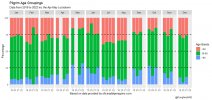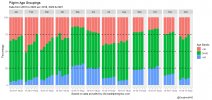DoughnutANZ
Ka whati te tai ka kai te tōreapango
- Time of past OR future Camino
- 2019, 2023, 2024, 2025, 2026, 2027 & 2028.
Below are a couple of charts drawn using data from the Pilgrim Office in Santiago de Compostela. These numbers only relate to Pilgrims who applied for a certificate from the Pilgrim Office. Please note that the three age bands are chosen by the Pilgrim Office and I am unable to alter these as I don't have the underlying raw data. The data is drawn from the data API on the Pilgrim Office website and I have done minor checks on it for errors. See the second chart for a comment on errors. The data for this first chart seems reasonable.
***** Please be aware however ***** that the bars represent percentage splits for the age bands and during January and February there are so few Pilgrims walking (typically less than 20 a month) that one individual or a small group can make a big difference and so I would urge readers to take care when ascribing meaning to percentages for these months. A typical March sees 100-200 Pilgrims complete and by April we usually see around a thousand a month. We then have peaks over the Summer and early Autumn months with typically tens of thousands completing per month. Numbers then drop rapidly towards December when we are back to hundreds per month.
The first chart shows data from 2019 through 2022. This includes data for 2020 when Covid lockdowns in Spain meant that no one completed during April and May 2020. This shows up in the charts as empty bars. I was interested in if there was a change in the makeup of the age bands for Pilgrims after the lockdowns and if this has since reverted to prior behaviour.
It would seem from these figures that immediately after the Covid lockdowns in Spain (April-May 2020) that less people aged over 60 were completing. This then looks like it reverted to previous percentages by July 2021. As previously mentioned January and February had too few completions to draw and confident conclusions.

The second chart contains data from 2016 to 2022 (currently incomplete). I have removed data for 2018 because something went wrong with the Pilgrim Office age band data for this year. May 2018 seems okay but all other months in 2018 have unusable data and so it was easiest and less confusing to simply delete all of 2018 data for this chart. Similarly 2020 and 2021 completions were effected by the Covid pandemic measures and so are atypical years and I excluded those years (although they are shown in chart 1) so as to get a better feel for stable longer term trends. Lastly, 2022 is not yet finished and I only have data up to the end of July 2022.
This second chart shows that Pilgrims aged over sixty tend to complete in greater percentages during May, June, September and October. On the other hand, under thirties tend to complete in greater numbers during July and August. With August being one of the least favoured months for completion for over sixties.
With the exceptions of March through May, the proportions of the age bands seems to have been remarkedly stable over these years. March is showing a trend towards less younger completions and more elderly completions over time. April and May are showing mixed changes with overall a slight increase in percentage of over sixties completions.

***** Please be aware however ***** that the bars represent percentage splits for the age bands and during January and February there are so few Pilgrims walking (typically less than 20 a month) that one individual or a small group can make a big difference and so I would urge readers to take care when ascribing meaning to percentages for these months. A typical March sees 100-200 Pilgrims complete and by April we usually see around a thousand a month. We then have peaks over the Summer and early Autumn months with typically tens of thousands completing per month. Numbers then drop rapidly towards December when we are back to hundreds per month.
The first chart shows data from 2019 through 2022. This includes data for 2020 when Covid lockdowns in Spain meant that no one completed during April and May 2020. This shows up in the charts as empty bars. I was interested in if there was a change in the makeup of the age bands for Pilgrims after the lockdowns and if this has since reverted to prior behaviour.
It would seem from these figures that immediately after the Covid lockdowns in Spain (April-May 2020) that less people aged over 60 were completing. This then looks like it reverted to previous percentages by July 2021. As previously mentioned January and February had too few completions to draw and confident conclusions.

The second chart contains data from 2016 to 2022 (currently incomplete). I have removed data for 2018 because something went wrong with the Pilgrim Office age band data for this year. May 2018 seems okay but all other months in 2018 have unusable data and so it was easiest and less confusing to simply delete all of 2018 data for this chart. Similarly 2020 and 2021 completions were effected by the Covid pandemic measures and so are atypical years and I excluded those years (although they are shown in chart 1) so as to get a better feel for stable longer term trends. Lastly, 2022 is not yet finished and I only have data up to the end of July 2022.
This second chart shows that Pilgrims aged over sixty tend to complete in greater percentages during May, June, September and October. On the other hand, under thirties tend to complete in greater numbers during July and August. With August being one of the least favoured months for completion for over sixties.
With the exceptions of March through May, the proportions of the age bands seems to have been remarkedly stable over these years. March is showing a trend towards less younger completions and more elderly completions over time. April and May are showing mixed changes with overall a slight increase in percentage of over sixties completions.










